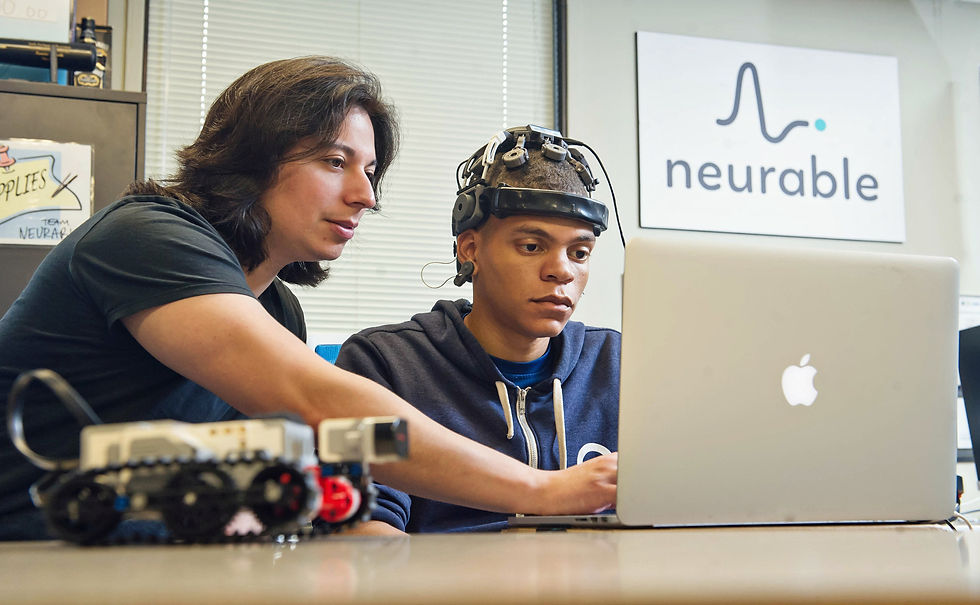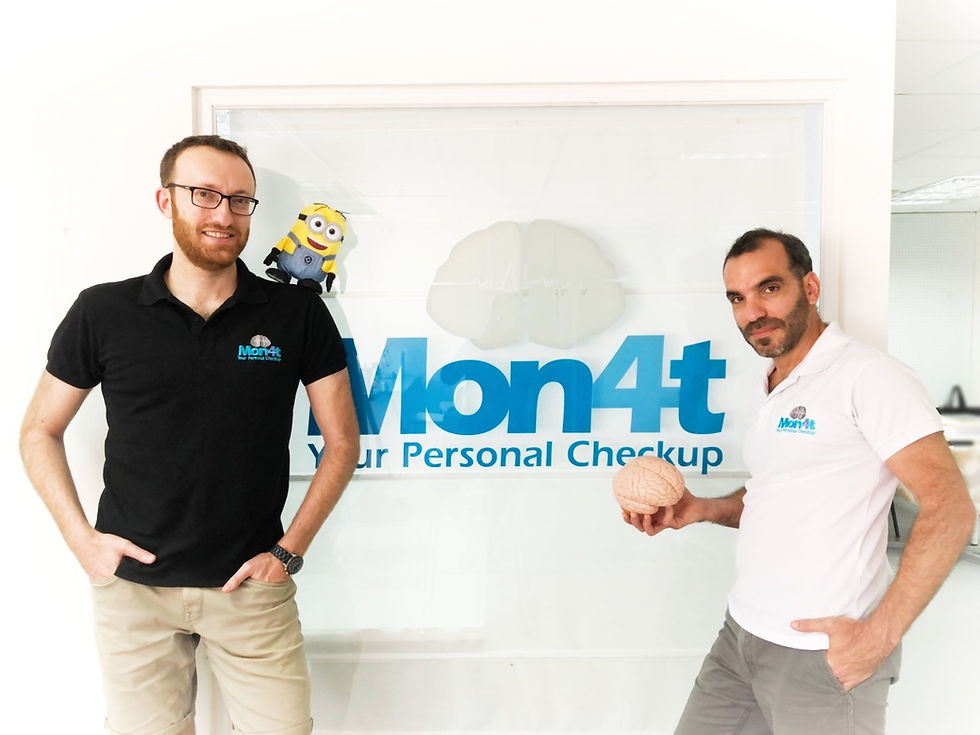Neurable Is Embedding EEG’s Into Everyday Headphones
- Dominic Borkelmans

- Aug 4
- 5 min read
Each day, we make hundreds of mental shifts, from deep focus to distraction, creative flow to cognitive fatigue. Yet, we have almost no visibility into what our brains are actually doing at any one moment. While a range of wearables now measure everything in your body, from your sleep to heart rate to Vo2 max, brain states remain largely unreadable in real time. However, it is precisely those brain states that contain the most valuable bio-data for those trying to optimise their cognitive health.
Boston-based Neurable is one of the few neurotechnology companies trying to solve that problem in the consumer space. Instead of invasive implants or clunky research headsets, they’ve developed a pair of sleek, sensor-laced headphones that measure brain activity while you work, offering real-time feedback on focus, fatigue, and mental load. By embedding dry EEG into premium audio hardware, Neurable aims to make cognitive monitoring frictionless, continuous, and actionable.
The Measurement Gap in Cognitive Health
Cognitive states like focus, fatigue, and mental overload have a profound influence on our productivity and well-being; the cost of fatigue in the workplace is believed to exceed $18 billion annually. Yet these states remain largely unmeasured. Neuroscience offers a range of reliable tools for assessing brain activity, but these are typically confined to research labs. Consumer wearables, meanwhile, attempt to infer mental state through proxies like heart rate or sleep patterns, offering indirect and often unreliable insights. The result is a gap between how we feel and what we can quantify.
Neurable, the name cleverly combining ‘wearable’ and ‘neuro’, addresses this gap by embedding dry-electrode electroencephalography (EEG) directly into everyday devices. Their approach uses proprietary machine learning models to monitor brain activity related to attention and fatigue. This data is processed in real time and translated into feedback that users can act on immediately. The goal is to enable more adaptive workflows, better-timed breaks, and insights into mental patterns over time.
Neurable’s first product, Enten, demonstrated that high-quality EEG could be captured through a comfortable, wireless headphone, no gels or clinical setup required. Their commercial follow-up, the MW75 Neuro, developed in partnership with Master & Dynamic, integrates 12 dry EEG sensors into a premium over-ear audio device. Through the accompanying app, users can initiate focus sessions, receive cognitive performance summaries, and track attention trends over time. It’s one of the first brain-computer interfaces designed not for clinical use or research, but everyday cognitive optimization.

Detecting Focus and Fatigue with Neurable's Headphones
The MW75 Neuro uses dry electrodes to record EEG signals from behind the ears, focusing on brainwave patterns linked to attentional state and mental fatigue. The system primarily monitors fluctuations in alpha (8–12 Hz) and theta (4–8 Hz) bands, which are known to correlate with cognitive load, vigilance, and task disengagement. Drops in sustained focus are reflected in increased frontal theta or rising alpha power, signatures associated with mind-wandering or reduced task engagement. Neurable’s algorithms analyze these dynamics in real time, using models trained on datasets from over 7,000 EEG sessions
In internal lab studies, Neurable benchmarked their EEG signal quality against clinical Quick20 systems using established neural markers like alpha waves and P300 responses. Signal performance was found to be comparable under controlled conditions, and the results were published in a white paper. Independent reviewers, including Wired and Digital Trends, confirmed the system’s effectiveness in stationary settings, while noting reduced accuracy during motion or poor electrode contact, limitations common to all dry EEG systems.
To rule out placebo effects, Neurable tested real-time feedback against sham conditions. Participants receiving true signal-based feedback showed stronger task alignment than those given randomized output. Still, detection accuracy averages around 80%, and results can vary with fit, hair type, or movement. These limitations make the system best suited for focused desk work rather than dynamic environments. Within that scope, the data suggests the product delivers reliable cognitive feedback rooted in measurable neural activity.
The Team, Funding, and Milestones Driving Neurable
Neurable was founded in 2015 by neuroscientist-engineer Dr. Ramses Alcaide, stemming from his work at the University of Michigan in developing early assistive EEG interfaces. Dr. Alcaide has emphasized the need to move EEG out of the lab into everyday life, stating about his product line: “It’s the most powerful wearable, tracking the most important organ in your body”. The team later added engineers and product veterans, accelerating development from research prototype to commercial product.

Neurable has raised over $10 million across multiple funding rounds backed by M Ventures, Point72 Ventures, and Innospark, with additional support from the Michigan Economic Development Corporation. Early investments fueled the development of the Enten prototype and the refinement of their proprietary EEG and AI platform. In 2023, they closed a pivotal commercial partnership with Master & Dynamic to launch the MW75 Neuro headphones at a retail price of $699 in the U.S., with planned expansion into Europe soon following.
Neurable progressed from University research, circa 2011, to a functional pilot prototype in 2021, followed by the commercial MW75 launch in late 2023. While the product is not FDA-cleared and is positioned as a non-medical device, its achievement lies in marrying dry-electrode EEG with premium consumer audio, a rare milestone in neurotech. With pilot studies across workplace settings underway, Neurable is now positioned to scale both hardware distribution and enterprise applications, cementing its role in mainstream cognitive tools.
Why It Matters
From a neuroscience perspective, Neurable’s work advances the long-standing goal of bringing cognitive state monitoring out of the lab and into everyday life. By embedding dry-electrode EEG into consumer-grade hardware, they are generating high-quality neural data in naturalistic settings, something that traditional systems have struggled to do at scale. This opens new avenues for studying attention, fatigue, and cognitive load in real-world contexts, while also laying the foundation for future neuroadaptive environments.
“It’s the most powerful wearable, tracking the most important organ in your body.”
From a business perspective, Neurable is creating a new category of consumer neurotechnology, one that combines real-time brain measurement with practical, user-facing applications. Rather than positioning itself as a medical device company, Neurable is focused on the productivity and wellness markets, where the regulatory path is faster and the user base broader. With a commercial product on the market, strong design partnerships, and a growing dataset of brain-state interactions, they are well-positioned to lead in cognitive wearables.
Conclusion
By combining validated neuroscience with thoughtful product design, Neurable is laying the groundwork for a new category of technology. A wearable that doesn’t track our behavior through physiological states, but by directly measuring the brain states driving it. Innovatively, it treats attention and fatigue as measurable dimensions of daily life. As the line between neurotech and consumer electronics begins to blur, Neurable offers a glimpse of how brain data might quietly integrate into the way we work, rest, and interact.



